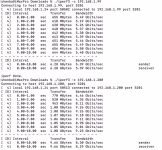BlueBenson
Cadet
- Joined
- Mar 21, 2023
- Messages
- 2
My Server is DELL R730XD the NIC is X540-AT2
I update the esxi8.0 and truenas 22.12.1(ALL NEW INSTALL). First i use vmxnet3 nic and i use iperf3 test the network speed,before i use Apps,the speed looks good(9.3Gbits/s),but after i set the pool for apps, the iperf3 show the speed only 5.1Gbits/s,even i unset the pool for apps, the speed still only 5.xGbits/s, then I add another SR-IOV mode nic to truenas vm and got 2 ip address, iperf3 test show the ip from vmxnet3 nic still 5.xGbits/s but the ip from the SR-IOV nic is 9.2Gbits/s. Next I test the passthrough nic again something strange has happened the iperf test of passthrough nic only 5.xGbits/s.
the 192.168.1.99 from vmxnet3
the 192.168.1.200 from SR-IOV
sorry i didn't get the passthrough nic test screenshot
I update the esxi8.0 and truenas 22.12.1(ALL NEW INSTALL). First i use vmxnet3 nic and i use iperf3 test the network speed,before i use Apps,the speed looks good(9.3Gbits/s),but after i set the pool for apps, the iperf3 show the speed only 5.1Gbits/s,even i unset the pool for apps, the speed still only 5.xGbits/s, then I add another SR-IOV mode nic to truenas vm and got 2 ip address, iperf3 test show the ip from vmxnet3 nic still 5.xGbits/s but the ip from the SR-IOV nic is 9.2Gbits/s. Next I test the passthrough nic again something strange has happened the iperf test of passthrough nic only 5.xGbits/s.
the 192.168.1.99 from vmxnet3
the 192.168.1.200 from SR-IOV
sorry i didn't get the passthrough nic test screenshot

